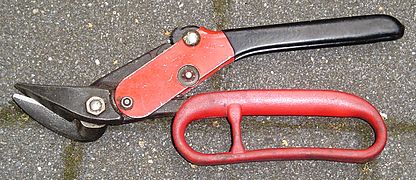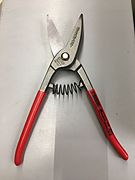Tin snips
A shearing machine is a tool chipless cutting of sheets of steel and non-ferrous metals . Sheet metal snips are used for dividing (cutting) by shearing (shearing). Both are non-cutting cutting processes in which two cutting edges move against one another and notch into the material . The axis that guides the scissor blades is itself heavily stressed by shearing .
Advantages of using tin snips over sawing the workpiece:
- easy handling without rattling, vibrating and hitting the flat workpiece, the workpiece does not need to be clamped and held down
- a burr-free cut with straight cut edges that require less rework than the irregular jagged edges of a saw cut ;
- often faster work progress
- When cutting with tin snips, there are virtually no chips that have to be collected and disposed of
Disadvantage:
- Since the edges are bent downwards or upwards when cutting, they often have to be straightened (smoothed) afterwards
variants
Guillotine
The guillotine shears are stationary tools that make longer, straighter, and faster cuts than hand-held tin snips. However, it is not suitable for curve cuts. A guillotine shears can be operated manually, electrically, hydraulically or pneumatically.
Nibbler
The nibbler or sheet metal nibbler is a type of tin snips with a short tongue that makes two cuts directly next to each other. Due to the parallel cut and the short cutting movement, the workpiece edges bend less than when cutting with simple scissors.
Hand-held tin snips
- Sheet metal shears
- lever-operated scissors
- Figure scissors or curved scissors with narrow scissor blades that give less guidance; the position of the scissor jaws determines whether right or left radii can be cut
With standard hand sheet metal shears, the cutting force results from the lever ratio of blade length to handle length. In the case of manual tin snips with leverage, the additional leverage reduces the effort required by at least about 25%.
A wide variety of specialized types of scissors have been developed for the diverse application tasks in practice. In addition to continuous scissors with long blades for straight cuts, there are figure scissors and ideal scissors. Depending on the direction of the curve, a distinction is also made between right and left scissors.
If the sheet does not lie flat on the cutting jaw, it warps more. The consequences are increased effort and shorter downtimes. The further the workpiece is pushed into the jaws of the scissors for cutting, the less effort is required for the cut. Counter pressure on the material can prevent it from slipping out. If the scissors are not closed completely when cutting, the edges will bend less.
High quality tin snips are characterized by:
- hardened forgings without burrs in the shear head and handle area
- cleanly ground cutting edges
- stable scissor head screw connection and handles
- easy cutting
- burr-free cuts
Hand tin snips are often used by locksmiths , plumbers , drywallers , roofers and bodybuilders .
Plate shears , 1930
Compressed air nibbler , around 1950






